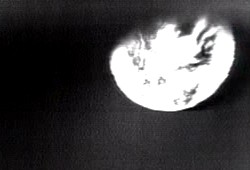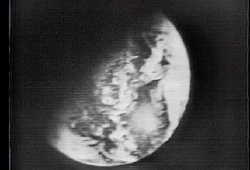Apollo 8 had onboard an RCA black and white slow-scan TV camera.
Like the Westinghouse Lunar Surface TV Camera used on Apollo 11, this produced a non-interlaced 320 line, 10 frames per second, picture which was scan-converted to 525 line 29.97fps (i.e. NTSC compatible) at the Goldstone and Madrid.
|
A promotional brochure on the RCA slow scan TV camera.
Bill Wood scanned Dick Nafzger’s copy of the brochure, replacing the halftone photos with scans of prints, courtesy of Dwight Steven-Boniecki. Click the image to download a 650kb PDF file.
(RCA’s Leo Weinreb is pictured holding the camera on page 2.) |
|
The MOCR during the second TV broadcast.
Live television from Apollo 8, via Goldstone, is displayed in the Mission Operations Control Room in Houston, 55:22 GET.
Paul Haney, “Voice of Mission Control”, is standing at right. NASA image s68-56007. |
During the mission, six broadcasts originated from Apollo 8. Five of these were relayed to Houston from Goldstone – and one from Madrid. (Until just before Apollo 11, there were no video circuits from Honeysuckle Creek to the outside world. While Apollo 8 TV was seen on station, it could not be released in real time.)
Where this recording came from
These video clips from Apollo 8 were on a tape loaned by Goddard Apollo TV Engineer Dick Nafzger to the Applied Physics Lab at Johns Hopkins University. The tape was rediscovered by Dick, and Stan Lebar, in January 2007, during the search for the Apollo 11 telemetry tapes. The tape was transferred back to Goddard, and a digital copy was made.
The 2 inch quadriplex tape contains daily mission highlights. These pictures were seen live worldwide during the mission. While only showing highlights from each day, this recording is generally better than other recordings I have seen. The picture instability at the start of each clip is an artifact of the tape playback.
RCA’s Elmer Fredd, who operated the Scan Converter at Sydney Video for the Apollo 11 EVA, was at Goldstone for Apollo 8. He operated the Goldstone Scan Converter for these historic broadcasts.
MPEG 4 files – highlights from Apollo 8 onboard TV
En Route to the Moon
|
 |
From TV Transmission 1.
031:08 GET.
Trans Lunar Coast.
Through Goldstone.
19.4 MB MPEG4 video file
(Duration:
5 min 11 sec.) |
From TV Transmission 2.
055:10 GET.
Trans Lunar Coast.
Through Goldstone.
20.2 MB MPEG4 video file.
(Duration:
3 min 35 sec.)
This simulation, adapted from Starry Night Apollo, provides orientation. |
From Lunar Orbit
|
 |
From TV Transmission 3.
071:40 GET.
Lunar Revolution 2.
Through Madrid.
(Honeysuckle had just had LOS.)
17.2 MB MPEG4 file
(Duration:
3 min 04 sec.) |
From TV Transmission 4.
086:05 GET.
Lunar Revolution 9.
Through Goldstone.
(Honeysuckle was in mutual view.)
Message “for all the people back on Earth”.
12.3 MB MPEG4 file or 24MB version.
(Duration:
3 min 23 sec.)
Update: See this upscaled version on Vimeo. |
On the way home
|
 |
From TV Transmission 5.
104:24 GET.
Trans Earth Coast.
166,000 miles from Earth.
Through Goldstone.
24 MB MPEG4 file
(Duration:
4 min 11 sec.) |
From TV Transmission 6.
128:02 GET.
Trans Earth Coast.
97,000 miles from Earth.
Through Goldstone.
21 MB MPEG4 file
(Duration:
3 min 33 sec.) |
Acknowledgements
With grateful thanks to Dick Nafzger of NASA’s Goddard Space Flight Center
and to the Applied Physics Lab at Johns Hopkins University.
(Audio enhanced and video digitised by Colin Mackellar.)
Back
to the main Apollo 8 mission page.
Back
to the Honeysuckle Creek home page.

